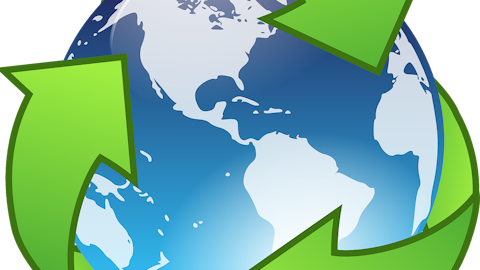Aris Water Solutions, Inc. (NYSE:ARIS) Q1 2024 Earnings Call Transcript May 8, 2024
Aris Water Solutions, Inc. isn’t one of the 30 most popular stocks among hedge funds at the end of the third quarter (see the details here).
Operator: Greetings, and welcome to Aris Water Solution 1Q 2024 Earnings Conference Call At this time, all participants are in a listen-only mode. A brief question-and-answer session will follow the formal presentation. [Operator Instructions] As a reminder, this conference is being recorded. It is now my pleasure to introduce your host, Mr. David Tuerff, Senior Vice President, Finance and Investor Relations. Thank you, Mr. Tuerff. You may begin.
David Tuerff: Good morning, and welcome to the Aris Water Solutions first quarter 2024 earnings conference call. I am joined today by our President and CEO, Amanda Brock, our Founder and Executive Chairman, Bill Zartler; and our CFO, Stephan Tompsett. Before we begin, I’d like to remind you that in this call and the related presentation, we will make forward-looking statements regarding our current beliefs, plans and expectations, which are not guarantees of future performance and are subject to a number of known and unknown risks and uncertainties and other factors that could cause actual results to differ materially from results and events contemplated by such forward-looking statements. You are cautioned not to place undue reliance on forward-looking statements.
Please refer to the risk factors and other cautionary statements included in our filings made from time to time with the Securities and Exchange Commission. I would also like to point out that our investor presentation and today’s conference call will contain discussion of non-GAAP financial measures, which we believe are useful in evaluating our performance. These supplemental measures should not be considered in isolation or as a substitute for financial measures prepared in accordance with US GAAP. Reconciliations to the most directly comparable GAAP measures are included in our earnings release and the appendix of today’s accompanying presentation. I’ll now turn the call over to our Founder and Executive Chairman, Bill Zartler.
Bill Zartler: Thank you, David. Aris is off to a great start in 2024, continuing our momentum and strong execution from last year to grow our produced water volumes while expanding our operating margins to a new record high. Our consistent performance is a testament to the hard work of our team, the continued production growth of our customers and our expansion in critical infrastructure. It’s been about two and a half years since we went public, and I think it’s important to reiterate what differentiates Aris. Over 80% of our revenue comes from currently flowing production volumes under long-term contracts with great well capitalized and active customers. These long-term infrastructure contracts provide revenue visibility and security as evidenced by our tenth consecutive quarter of produced water volume growth.
We paired those volumes with continued margin expansion, reaching a new high for adjusted operating margin per barrel in the first quarter. Consistent volumetric growth and now record profitability are leading to accelerating earnings growth, which we are combining with an enhanced capital efficiency. As our asset footprint has increased in scale, we’re now reducing our capital spending by approximately 40% year-over-year versus 2023. Combined with our accelerating earnings profile, we’ve reached a point where we can generate excess cash and are modifying our capital allocation framework to return additional capital to shareholders. We’re off to a great start and are encouraged by our outlook for the rest of the year. With that, I’ll turn it over to Amanda.
Amanda Brock: Thank you, Bill. As Bill said, we’re off to a fantastic start this year, continuing our positive momentum and consistent growth. Volumetrically, we grew our produced water volume 6% sequentially and 19% year-over-year. We achieved adjusted EBITDA of $53 million for the quarter, up 8% sequentially and up nearly 40% year-over-year. While quarterly volumes will fluctuate with our customers’ activity, our long-term volumetric growth is supported by our long-dated infrastructure contracts in the core of the Permian Basin, covering over 625,000 contracted acres with premier operators, which deliver stable, growing and reliable revenues. In the Water Solutions business, we sold 364,000 barrels of water per day, down seasonally from the fourth quarter as anticipated, but ahead of our expectations.
And as we stated last quarter, we expect Water Solutions sales to ramp throughout the year. In the first quarter, we also achieved a record adjusted operating margin of $0.46 per barrel. This high point reflects the benefits of not only top line growth from inflation escalators in our long-term contracts, but also cost improvements from our now substantially complete electrification efforts and additional efficiencies such as reduced chemical costs and improved processes for solid waste handling. We also benefited from a pull-forward of volumes and skim oil proceeds, as well as delays in scheduled maintenance in the quarter, which Steve will elaborate on. Absent these timing impacts, our margins have successfully recovered from the inflationary pressures we saw in late 2022.
And I want to congratulate our team for the hard work, dedication and creativity required to not only restore our profitability but also exceed our targets. Quarterly timing aside, we continue to benefit from the deep inventory of highly economic acreage that our long-term contracted customers are committed to developing in the Northern Delaware Basin. Our consistent growth in volumes, record profitability, efficient capital spending, and significant out performance in the first quarter has given us increased confidence in the growth of our free cash flow. As a result, we are increasing our quarterly dividend 17% to $0.105 per share. Our capital return priorities remain the same. We will prioritize balance sheet strength and flexibility. We will invest in high-return organic growth capital and return excess free cash flow to shareholders in line with the business’s growth over time.
As early leaders in the development of the Energy Water Infrastructure business, we look to the future of the industry by developing and advancing technologies and beneficial reuse and mineral extraction. The current desalination pilot projects we are leading with the consortium of ConocoPhillips, Chevron and ExxonMobil are scheduled to be completed by the end of the third quarter. At this point, we have successfully tested two desalination and treatment processes and are currently testing a third, which could also meet standards for applier replenishment, agricultural and other industrial uses. The next phase of the trial is to evaluate the most cost-effective means of scaling these technologies. As we progress our efforts, in the second quarter, we will be working with the Texas Railroad Commission for a land use permit for surface discharge are produced quarter related to our DOE-funded project which will use treated produced water for nonconsumptive agriculture.

Additionally, after testing our produced water for over a year, we’ve developed a better understanding of our produced water minerals content across our assets. We have focused our efforts on high-value minerals that can possibly be economically recovered. We are now evaluating technologies and potential partnerships for the commercialization of brine mining and minerals recovery from our produced water and concentrated brine. While we are focused on significant opportunities in our core Water Gathering Infrastructure and Recycling business, we are taking the lead in developing future options for sustainable full cycle water management for the energy industry. And with that, I’ll turn it over to Steve to discuss our financial results for the quarter and details on our outlook for the rest of the year.
Stephan Tompsett: Thank you, Amanda. We recorded adjusted EBITDA for the first quarter of $53.1 million, up 39% from the first quarter of 2023 and up 8% sequentially from the fourth quarter of 2023, again exceeding our expectations for the quarter. The sequential increase was due to earlier and larger flowbacks from new well connections and associated skim oil, as well as the benefit of both top line CPI escalators and cost savings initiatives such as our electrification efforts. As we mentioned last quarter, our 2024 capital program is front-end weighted. We invested approximately $38 million in the first quarter, slightly ahead of our expectations due to early completion of budgeted projects and we remain on track for full year CapEx of $85 million to $105 million, consistent with our prior guidance.
Looking ahead to the second quarter, we expect produced water volumes to be between 1.02 million and 1.05 million a day, down sequentially from the first quarter due to the pull forward of volumes referenced earlier, we’re forecasting skim recoveries of approximately 1,200 barrels of oil per day. For the Water Solutions business, we expect second quarter volumes to average 400,000 to 430,000 barrels per day, up approximately 15% sequentially over the first quarter as activity ramps throughout the year. As Amanda mentioned, we had an approximately $4 million pull forward of EBITDA, driven primarily by acceleration of contracted volumes and associated skim oil, as well as delayed well maintenance costs. Adjusting for these timing differences, we believe we will continue to maintain margin improvements with adjusted operating margins anticipated to be between $0.42 and $0.44 per barrel for the second quarter, delivering adjusted EBITDA between $44 million and $48 million.
This includes the impact of the deferred maintenance expense from the first quarter. For the full year, we now expect adjusted EBITDA to be in the range of $185 million to $200 million, as we are breaking up the bottom end of the range to reflect the first quarter outperformance. Turning to our balance sheet. We ended the quarter with a healthy 2.15x debt-to-adjusted EBITDA ratio, below the low end of our long-term leverage target and $345 million of available liquidity which provides us with significant financial flexibility. Finally, we are raising our quarterly dividend 17% to $0.105 per share to be paid June 20 to shareholders of record as of June 6. This increase in shareholder payout reflects our confidence in our contracted volume outlook, sustainable margin recovery and the growing free cash flow we expect over the course of 2024 and beyond.
Looking forward, we will continue to evaluate the dividend periodically as part of our overall capital allocation framework and anticipate increasing shareholder returns over time in line with business growth in a sustainable manner, which allows for additional investment in high-return business development opportunities, while maintaining financial strength. With that, I’ll turn it over to Amanda to wrap up.
Amanda Brock: Thanks, Steve. In closing, I want to again congratulate our talent and a dedicated team on the start to the year and to thank our customers for their continued confidence and our ability to deliver critical water management solutions. Our focused effort on margin recovery has pushed margins to new highs, alongside further optimized capital spending. We’re running the business more efficiently and is evident in our results. We are seeing increased demand for our water infrastructure and full cycle water treatment capabilities, as operators further recognize the critical nature of reliable water management to their operations. We remain confident in our ability to increase free cash flow and shareholder returns, both in 2024 and beyond, as reflected by our dividend increase this quarter.
Alongside the solid performance in our core business, we are leading the future of water technology, preserving scarce groundwater resources in the areas in which we operate and extracting additional value from complex wastewater streams. And with that, we are happy to take questions.
Operator: Thank you. We will now be conducting a question-and-answer session [Operator Instructions] The first question comes from the line of John Mackay with Goldman Sachs. Please go ahead.
John Mackay: Hey, good morning. Thank you for the time. Maybe we’ll start on the margin side if you don’t mind. You guys have made a lot of progress and kind of working through some of those OpEx issues. Maybe just can you break down for us if you’re backing out the $4 million of incremental gains this quarter? Just what underlying margin strength looked like? And then how we should think about that moving from here?
See also 11 Best Recession Dividend Stocks To Buy and 15 Worst States to Work in the US.
Q&A Session
Follow Ari Network Services Inc (NYSE:ARIS)
Follow Ari Network Services Inc (NYSE:ARIS)
Receive real-time insider trading and news alerts
Amanda Brock: Thanks, John. Yes, happy to do that. We’ve discussed before and as we’ve talked about, we saw a high point of margins this quarter at the $0.46. We also have indicated that we saw a pull forward of about $4 million. So when you normalize that we think this quarter was still an all-time high at about $0.43, which is what we’ve also guided to in Q2. But Steve, why don’t you go ahead and break that down in terms of what we saw with increased flow backs and how we account for that $4 million pull forward.
Stephan Tompsett: Yes, John. The $4 million pull forward, there was some volume we originally expected in Q2, which we saw come forward in Q1, both earlier timing as well as larger volumes and then there was associated skim oil with some of our volumes that was well in excess of what we see typically. We also see some CPI escalators come in January each year. So we had some uptick in some of our contracts so we see some revenue there. Going forward as Amanda alluded to it’s about $0.03 per barrel on the margin side, that was in Q1 that would be the onetime item.
Amanda Brock: We had some maintenance items push into Q2.
Stephan Tompsett: Yes it’s true. We had about $2 million of R&M expense related to wealth and maintenance that’s going to go into Q2.
Amanda Brock: And that was just more of a timing issue. As we look forward we’re very pleased with the progress that we’ve made. We guide $43 million. That is a high. And so overall, we think is sustainable and we continue to look at our operations, how we are running our operations to find additional efficiencies, which we still see opportunities but they won’t be sort of some of the big strides forward that we were able to take in 2023 in this quarter.
John Mackay: I appreciate that detail. All makes sense. Maybe just turning to the dividend. Congrats on the announcement. Maybe if you could just kind of frame up, how you thought about the size of the increase? I know Stephen you talked a little bit about the growth pace going forward but maybe you could kind of just talk about the balance between investing in the business, growing the dividend and any other kind of capital allocation pieces you might have? How do we think about that going forward?
Amanda Brock: Great question. Steve why don’t you go ahead and sort of talk about the deliberations on this one?
Stephan Tompsett: Yes. John, we’ve been thinking about growing shareholder returns now over the last couple of quarters. And given the outperformance in Q1 and given the forecast for reduced capital it seemed like the best time to go ahead and start increasing shareholder returns. Looking forward, we look to assess it periodically and we do expect to grow shareholder returns alongside growth in EBITDA and free cash flow over time that could come through annual dividend increases or could come through share repurchases, which is something that we’ve considered. So it’s going to be in a measured pace that’s sustainable and doesn’t impede the balance sheet anyway.
John Mackay: Appreciate that. Thank you very much. Yes.
Amanda Brock: On your question on how we’re going to grow the business, considering how we look at the dividend in the future, it’s organic and inorganic. We have great organic opportunities. We continue to pursue opportunities in our area. We’ve got great infrastructure, great customers. It’s core of the Permian Basin. I think on the inorganic side Bill, would you like to…
Bill Zartler: I mean look at the dividend, it is still a relatively low portion of our cash flow. So from a traditional MLP coverage ratio perspective we’re – we made a commitment to keep the dividend and we’ll keep it there. It’s got plenty of room to continue to grow or we use that cash to reinvest the balance sheet’s in great shape. So we’re not having to do any repair work there. And so we’ll see how – we will evaluate these as we continue to grow along the way. And we’ve reserved here with capital that included in the current plan which does include some growth along with the core maintenance capital.
John Mackay: All right. That’s clear. Thank you.
Operator: Thank you. Next question comes from the line of Spiro Dounis with Citi. Please go ahead.
Spiro Dounis: Thanks, operator. Good morning, team. I just want to pick up on some of those last comments. You all talked about your capital allocation priorities balance sheet first. But as you described you’re sort of below your leverage target here seems to have a lot of dry powder, but second came growth capital and investing there. And so I was hoping to get maybe a little bit more color. One with respect to M&A just curious what the opportunity set looks like right now. And then with respect to commercial it was tough for us to see kind of what’s going on beneath the surface. But curious as you think about grabbing more market share there what that market looks like today and just how to think about some of the competitive dynamics?
Amanda Brock: Good morning, Spiro. Certainly on M&A, we’ve talked about it consistently that this is something we would like to do under the right circumstances if it’s accretive I mean it strategically helps us expand our footprint and we can do more with the assets. But why don’t you sort of talk about the landscape right now?
Bill Zartler: Yes. They’re still based on where we’re valued a bit of a gap between seller expectations and where we’re valued. Ultimately, we’re very comfortable and highly confident our assets our customers and our contracts. And looking at other businesses there’s a relative difference in some cases. In some cases it’s small in some cases is large in this business. So there’s a as this water industry has evolved and developed the way they have — businesses have grown has been very different in approaches around contracting and around building assets. And so we’re very careful in evaluating and valuing bolt-on acquisitions. We do think there’s some synergies there. We do like the additional size that could give us, but we’re not going to do anything that doesn’t ultimately make great economic sense for our shareholders.




